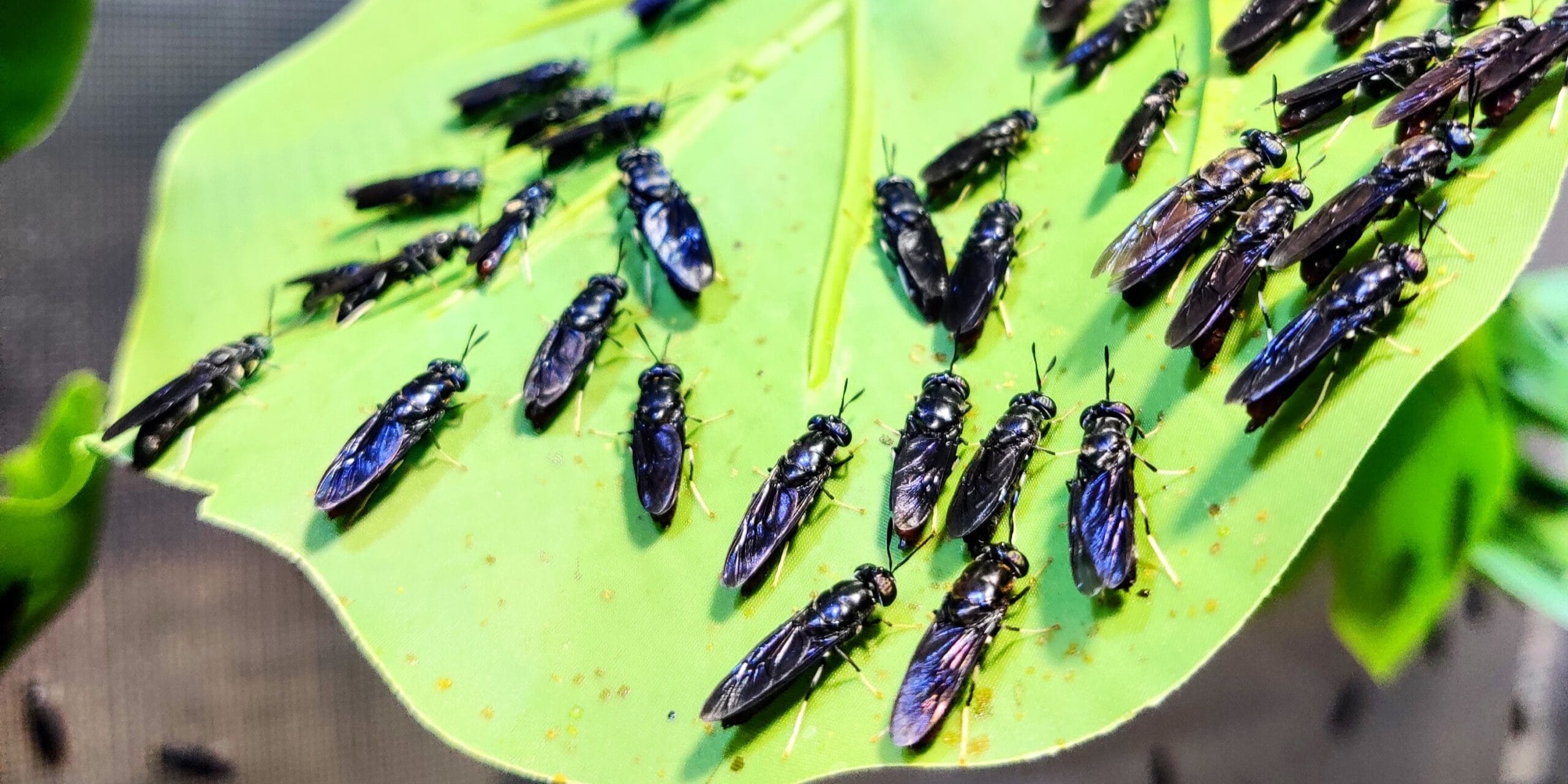
The Life Cycle of Black Soldier Fly
The black soldier fly (Hermetia illucens) is a fascinating insect known for its ecological and agricultural benefits. Its life cycle consists of five main stages: egg, larvae, pupa(e), adult, and reproduction. Each stage serves a critical purpose in its development and role in the environment. Depending on the source, there are often also mentioned stages such as “neonates”, meaning the very small larvae that have just hatched from eggs, and “Pre-pupa”, which is again the very early stage of pupa phase of larvae growth.
1. Egg Stage
Female black soldier flies lay their eggs in clusters typically near decomposing organic matter, such as food waste or manure, or in a BSF farming environment to particular egg traps, sometimes with special fragrance to attract the fly to lay eggs – the fragrant has not been proved to be critical in the egg-laying process, as in many production setups wooden egg traps attract the fly to high extent to lay eggs. Each female can lay up to 500 eggs. These tiny, cream-colored eggs hatch within 3-4 days, ushering in the larval stage. The phase right after hatching is often called “neonate”-stage.
2. Larval Stage
Larvae is the most significant phase of the black soldier fly’s life cycle. It lasts anywhere from 7-30 days, most often 7-15 days, depending on environmental conditions. During this period, the larvae voraciously consume organic material, breaking it down and converting it into high-quality protein and compost called “frass”, which is a good source of nutrients to be used in plant growing as a fertilizer. Overall, the frass is considered all the leftovers of the eating process, including insect exoskeletons and food ingredients that the larvae hasn’t been able to consume, such a very dry and fibrous matters. This all makes black soldier fly larvae valuable for waste management and as a sustainable feed source for livestock, aquaculture, and an interesting choice as a pet food protein source.
3. Pupal Stage
After reaching maturity, the larvae transition into the pupal stage. They burrow into dry areas to develop. The pupae are non-feeding and remain inactive for about 7-14 days as they undergo metamorphosis, preparing to emerge as adults.
4. Adult Stage
Adult black soldier flies are striking with their black bodies and translucent wings. They live for only 5-8 days, during which they do not eat. Instead, they focus on reproduction, relying on energy reserves from their larval stage. They do not sting or bite, and they don’t bother humans or other animals as such.
5. Reproduction
The adult black soldier flies mate shortly after emerging. Males establish territories to attract females, and once mating occurs, females lay eggs, completing the life cycle.
The neonate stage of the black soldier fly refers to the very first stage of the larval phase, immediately after the eggs hatch. This is a critical phase in the life cycle, as the tiny larvae (or “neonates”) are highly vulnerable and must quickly begin feeding to grow and develop.
The Neonate Stage
1. Size and Appearance:
◦ Neonate larvae are extremely small, typically less than 1 mm in length.
◦ They are pale, translucent, and soft-bodied, making them delicate at this stage.
2. Feeding and Behavior:
◦ Neonates begin feeding almost immediately upon hatching.
◦ They rely on moist, nutrient-rich organic matter (such as decomposing food or agricultural waste) for sustenance.
◦ Rapid feeding during this stage kick-starts their development and energy accumulation.
3. Growth Rate:
◦ This stage is very short, lasting only 1–2 days, depending on environmental conditions like temperature and humidity.
◦ Neonates grow rapidly and soon transition into larger, more robust larvae.
Importance of the Neonate Stage
The neonate stage is crucial because it sets the foundation for the larvae growth. Adequate access to food and optimal environmental conditions during this phase significantly impact the larvae overall development, health, and productivity. In controlled farming systems, maintaining proper conditions for neonates, such as consistent moisture and a suitable substrate, ensures high survival rates and efficient waste processing.
Though short, the neonate stage represents the beginning of the black soldier fly’s essential role in recycling organic material and contributing to sustainable systems.
The pre-pupa stage
The pre-pupa stage of the black soldier fly is a transitional phase between the larval and pupal stages. This stage occurs after the larvae has fully grown and is preparing to enter metamorphosis. Here’s a breakdown of what happens during the pre-pupal stage:
Characteristics of the Pre-Pupa Stage
1. Appearance and Behavior:
◦ The pre-pupa darkens in color, often turning brown or black, as it prepares for the pupal phase.
◦ It becomes less active and stops feeding, focusing its energy on finding a suitable place to pupate.
2. Migration:
◦ Unlike the active, feeding larvae, pre-pupae instinctively seek dry, secure locations to burrow or hide. This is a survival strategy to protect themselves from predators and environmental threats while they undergo metamorphosis.
3. Nutritional Composition:
◦ Pre-pupae are highly nutritious, with a high fat and protein content, which makes them an ideal feedstock for livestock or aquaculture. This stage is often targeted for harvesting in black soldier fly farming.
4. Duration:
◦ The pre-pupa stage typically lasts a few days (2–5 days) before the insect transitions into the pupal stage. The exact duration depends on environmental conditions like temperature and humidity.
Role of pre-pupae in the Life cycle
The pre-pupa stage is a preparatory phase, where the insect conserves energy and undergoes physiological changes necessary for pupation. During this time, its body becomes more rigid, and internal processes begin shifting towards the transformation into an adult fly.
In black soldier fly farming systems, pre-pupae are a crucial phase for harvest, as they have the highest nutritional value and are easier to collect due to their migration behavior.
In summary, the life cycle of a black soldier fly is efficient and fast. Their ability to recycle organic waste and serve as a protein source highlights their ecological importance and potential as a sustainable solution in waste management and agriculture in various ways.
Learn more about BSF farming in the
Insect Farm Hub!
Manna Insect has launched a comprehensive insect farming platform designed for learning, managing, monitoring and networking. There are tons of free content about insect farming, as well as a lot of paid premium content, that dives even deeper in black soldier fly business.
